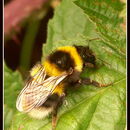Biology
(
Anglèis
)
fornì da Arkive
The exceptionally long tongue of this species allows it to obtain nectar from plants with deep-tubed flowers, which honeybees and other bumblebees cannot exploit (5). It is an important pollinator of fruit trees and clover, and also visits deadnettle, foxgloves, cowslips and a range of other plants (4).
Colonies contain between 50 and 120 insects, and are present between late April and early October (2). The queen is the only member of a colony to survive the winter, they emerge in April and begin to search for a suitable place in which to establish a nest (7). Nests are typically made underground, in banks and among tree roots (2), or occasionally above ground in bird boxes (7). The queen creates a circular chamber in which she builds a wax egg cell, and she lays her first batch of eggs inside. The eggs are laid on a layer of pollen, which is collected by the queen, and then covered with a layer of wax (5). After hatching, the white larvae are fed on honey and pollen by the queen. When they are fully-grown, the larvae cease to feed and develop into pupae after spinning a protective silk cocoon around themselves. During the pupal stage, the larvae undergo complex changes, and develop into adult workers. Throughout their development, the queen incubates this first brood by lying over the cell in which they grow, keeping them warm with the heat of her body. After emerging, the workers undertake the duties of foraging and nest care, and the queen remains inside the nest, producing further batches of eggs. When the colony reaches its peak, males and new queens are produced. Males develop from unfertilised eggs; after leaving the nest they fly around in search of new queens with which to mate. In this species, males are present between June and October, but their numbers peak towards the end of July (2). After mating, these new queens search for a place to hibernate. The colony and the old queen gradually die, and the newly mated queens emerge the following spring, to establish new colonies (5).
Conservation
(
Anglèis
)
fornì da Arkive
Specific conservation action has not been targeted at this species.
Description
(
Anglèis
)
fornì da Arkive
This is a large bumblebee, which has a fairly 'scruffy' appearance with long hair (3). It is a yellow, black and white banded species (2), with a long head. The tongue, which is as long as the body, is the longest of all bumblebees found in central Europe (4). Three 'castes' occur within bumblebee nests, a 'queen' (the reproductive female), 'workers' (non-reproductive females) and males (5). All three castes are broadly similar in appearance, but males can be distinguished as they lack stings and have longer antennae than females (5).
Habitat
(
Anglèis
)
fornì da Arkive
Found in a range of habitats, including the edges of woodlands and scrubby areas, and is common in gardens (1).
Range
(
Anglèis
)
fornì da Arkive
This species is one of the commonest and most widespread of bumblebees in Britain (1). It is found throughout the Palaearctic region, and has been introduced to New Zealand and Iceland (6).
Status
(
Anglèis
)
fornì da Arkive
Abundant throughout Britain (3).
Threats
(
Anglèis
)
fornì da Arkive
Many British bumblebee species have undergone a worrying decline, largely as a result of changes in agricultural practices leading to a loss of open habitats and important food plants (8).

